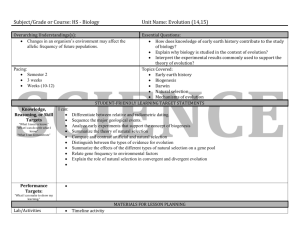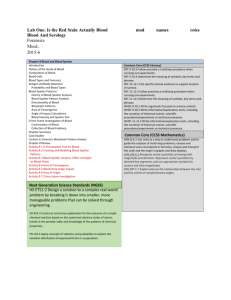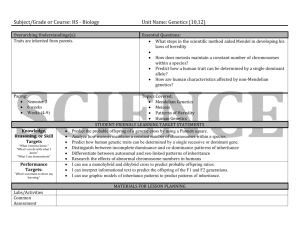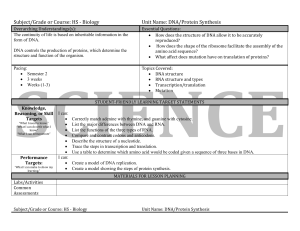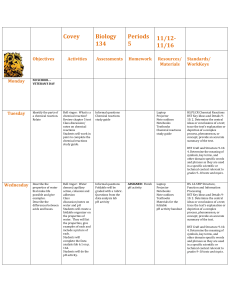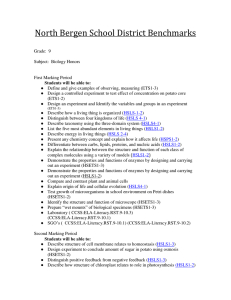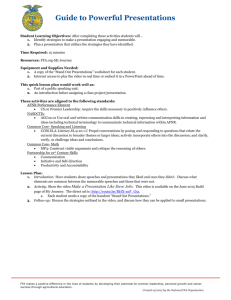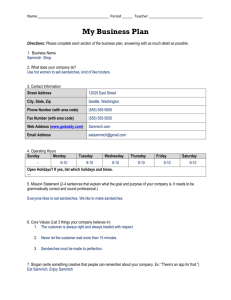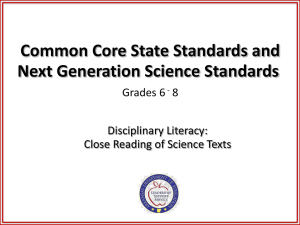Nature of Science
advertisement
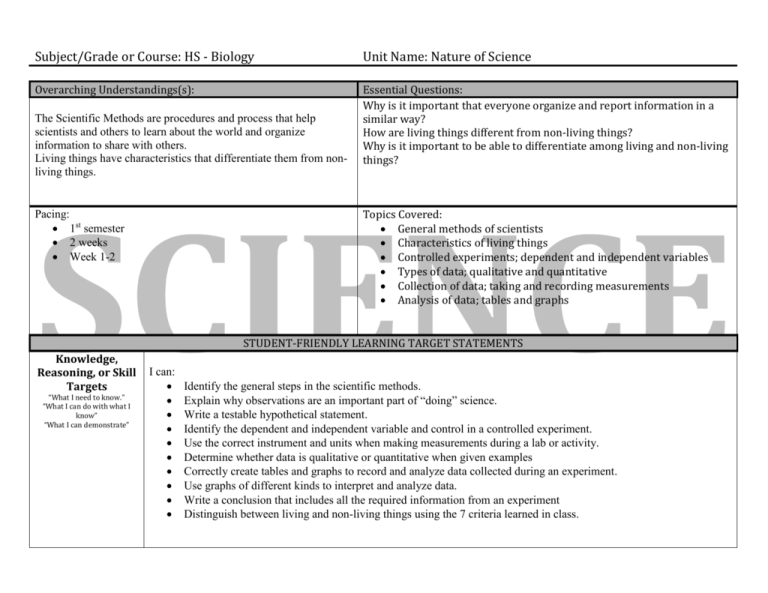
Subject/Grade or Course: HS - Biology Unit Name: Nature of Science Overarching Understandings(s): Essential Questions: Why is it important that everyone organize and report information in a similar way? How are living things different from non-living things? Why is it important to be able to differentiate among living and non-living things? The Scientific Methods are procedures and process that help scientists and others to learn about the world and organize information to share with others. Living things have characteristics that differentiate them from nonliving things. Topics Covered: General methods of scientists Characteristics of living things Controlled experiments; dependent and independent variables Types of data; qualitative and quantitative Collection of data; taking and recording measurements Analysis of data; tables and graphs Pacing: 1st semester 2 weeks Week 1-2 STUDENT-FRIENDLY LEARNING TARGET STATEMENTS Knowledge, Reasoning, or Skill Targets “What I need to know.” “What I can do with what I know” “What I can demonstrate” I can: Identify the general steps in the scientific methods. Explain why observations are an important part of “doing” science. Write a testable hypothetical statement. Identify the dependent and independent variable and control in a controlled experiment. Use the correct instrument and units when making measurements during a lab or activity. Determine whether data is qualitative or quantitative when given examples Correctly create tables and graphs to record and analyze data collected during an experiment. Use graphs of different kinds to interpret and analyze data. Write a conclusion that includes all the required information from an experiment Distinguish between living and non-living things using the 7 criteria learned in class. Performance Targets: “What I can make to show my learning.” Perform a lab and correctly complete a lab report using the Scientific Methods Create an organizer to show the 7 characteristics of life and their relative importance and defend placement of the most important and least important characteristics in the table. Earn at least a 70% on the Chapter 1 test. MATERIALS FOR LESSON PLANNING Labs/Activities Common Assessments “Magic Milk” lab, Cornell style notes on Chapter 1, Notes from teacher, Work with a group to create tables and graphs from data, pH quick lab to practice collecting, recording and graphing data, graph analysis homework – “insecticides”, Daily warm-ups, 3,2,1 Contact video on Experiments notes section reviews and/or worksheets Practice test on Chapter 1 Chapter 1 test Subject/Grade or Course: HS - Biology Idaho State Content Standards 9-10.B.5.2.1 Explain how science advances technology. (655.01a) CL: E Content Limit: Use scientists whose discoveries have significance and ramifications in today’s world to frame items. 9-10.B.5.2.2 Explain how technology advances science. (655.01a) CL: E Unit Name: Nature of Science Corresponding NGSS Students who demonstrate understanding can: LS1.A: Structure and Function Explain that systems of specialized cells within organisms help them perform the essential functions of life. (HS-LS1-1) CCSS ELA SL.9-10.2 Integrate multiple sources of information presented in diverse media or formats (e.g., visually, quantitatively, orally) evaluating the credibility and accuracy of each source. RST.9-10.9 Compare and contrast findings presented in a text to those from other sources (including their own experiments), nothing when the findings support or contradict previous Content Limit: Use common pieces of technology (lenses, electricity, computers, etc.) as the foundation for items that lead students to see the role technology has in advancing science. 9-10.B.5.2.3 Explain how science and technology are pursued for different purposes. (656.01b) CL: E Content Limit: Items should address the role of technology in applying science to improve some aspect of human life, and the role of science in answering questions and extending knowledge. Goal 1.1: Understand Systems, Order, and Organization Goal 1.2: Understand Concepts and Processes of Evidence, Models, and Explanations Goal 1.3: Understand Constancy, Change, and Measurement Goal 1.4: Understand the Theory that Evolution is a Process that Relates to the Gradual Changes in the Universe and of Equilibrium as a Physical State Goal 1.5: Understand Concepts of Form and Function Goal 1.6: Understand Scientific Inquiry and Develop Critical Thinking Skills Goal 1.7: Understand That Interpersonal Relationships Are Important in Scientific Endeavors HS-ETS-ED Engineering Design d. Plan and carry out a quantitative investigation with physical models or prototypes to develop evidence on the effectiveness of design solutions, leading to at least two rounds of testing and improvement. [Clarifying Statement: F or example, physical models or prototypes to conduct a quantitative investigation to determine if an ultraviolet light can purify water equally well as a chlorine-based system.] e. Use computational thinking to create, simulate, and compare different design solutions, checking to be certain that the simulation makes sense when compared with the real world. [Clarifying Statement: For example, students create a computer simulation of a model building to see how different modifications could save energy and reduce CO 2 emissions.] [Assessment Boundary: Students use existing modeling software.] f. Refine a solution by prioritizing criteria and taking into account the life cycle of a given product or technological system and factors such as safety, reliability, and aesthetics to achieve an optimal solution. [Clarifying Statement: F or example, choose the best possible heat pump technology for a campus building; determine the optimum method for extracting oil and natural gas; or best method for treating soil prior to planting crops.] explanations or accounts. SL.11-12.2 Integrate multiple sources of information presented in diverse formats and media (e.g., visually, quantitatively, orally) in order to make informed decisions and solve problems, evaluating the credibility and accuracy of each source and noting any discrepancies among the data. RST.11-12.9 Synthesize information from a range of sources (e.g., texts, experiments, simulations) into a coherent understanding of a process, phenomenon, or concept, resolving conflicting information when possible. RST.9-10.3 Follow precisely a complex multistep procedure when carrying out experiments, taking measurements, or performing technical tasks, attending to special cases or exceptions defined in the text. RST.9-10.7 Translate quantitative or technical information expressed in words in a text into visual form (e.g., a table or chart) and translate information expressed visually or mathematically (e.g., in an equation) into words. RST.11-12.3 Follow precisely a complex multistep procedure when carrying out experiments, taking measurements, or performing technical tasks; analyze the specific results based on explanations in the text. WHST .9 Draw evidence from informational texts to support analysis, reflection, and research. Goal 1.8: Understand Technical Communication
